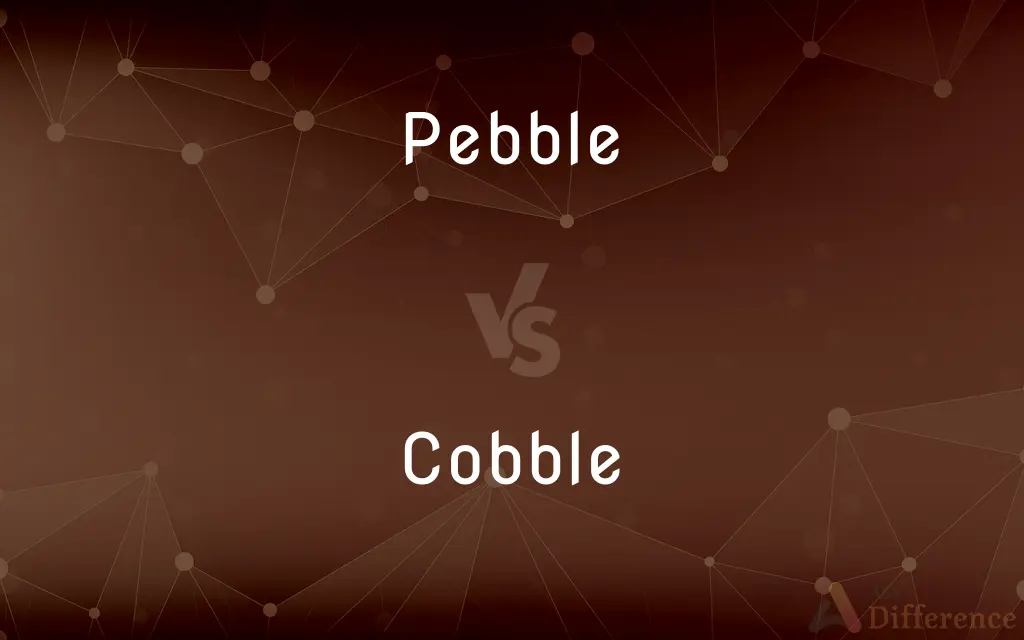Pebble vs. Cobble — What's the Difference?
By Urooj Arif & Fiza Rafique — Updated on March 28, 2024
Pebbles are small, rounded stones, often smoothed by water or erosion, whereas cobbles are larger, typically less rounded stones used in paving or construction.

Difference Between Pebble and Cobble
Table of Contents
ADVERTISEMENT
Key Differences
Pebbles are small, smooth stones found on beaches and riverbeds, shaped by the continuous action of water and sand. Whereas, cobbles are larger, rougher, and often used in construction for pavements or architecture, showcasing a distinct difference in size and application.
Pebbles, being smaller than 64mm in diameter, are often used in landscaping, garden decor, and in aquariums for their aesthetic appeal. On the other hand, cobbles, with sizes ranging from 64mm to 256mm, are utilized in constructing durable and visually appealing pathways, driveways, and buildings.
The formation of pebbles involves long-term weathering and erosion, making them smoother over time. Whereas cobbles, although also formed through geological processes, retain a more irregular shape and texture, highlighting their resilience to natural forces.
Pebbles are typically collected for their beauty, variety of colors, and patterns, making them popular among hobbyists and collectors. Cobbles, however, are valued for their structural qualities and are selected based on their strength, size, and suitability for construction purposes.
The environmental impact of extracting pebbles can lead to beach erosion and habitat loss, prompting conservation efforts. Conversely, the extraction of cobbles, while also impactful, is often regulated within the construction industry to minimize environmental damage.
ADVERTISEMENT
Comparison Chart
Size
Less than 64mm in diameter
Between 64mm and 256mm in diameter
Texture
Smooth, rounded by water or erosion
Rougher, irregular, less influenced by erosion
Usage
Landscaping, garden decor, aquariums
Construction, paving, architecture
Formation
Long-term weathering and erosion
Geological processes, less rounded
Environmental Impact
Can lead to beach erosion and habitat loss
Extraction regulated to minimize environmental damage
Compare with Definitions
Pebble
Characterized by their smooth and rounded surfaces.
Walking barefoot on the smooth pebbles at the riverbank felt therapeutic.
Cobble
Used in constructing durable pathways, driveways, and building exteriors.
The contractor recommended using cobbles for the driveway to ensure longevity.
Pebble
Formed by the continuous action of water and sand over time.
Over centuries, the river's flow turned ordinary rocks into smooth pebbles.
Cobble
Created through geological processes, retaining a more irregular shape.
The cobbles used in the garden wall were sourced from a local quarry.
Pebble
A small, rounded stone, typically smoothed by water or erosion.
The child collected pebbles from the beach to decorate her sandcastle.
Cobble
A larger, typically rougher stone used in construction and paving.
The old town's streets were lined with ancient cobbles, adding to its charm.
Pebble
Collection can contribute to beach erosion and habitat destruction.
Excessive pebble collection from the shoreline has led to noticeable beach erosion.
Cobble
Has a rougher, more irregular surface than pebbles.
The uneven cobbles of the pathway provided a rustic look to the landscape.
Pebble
Commonly used in landscaping and garden decor for their aesthetic appeal.
They spread colorful pebbles around the garden path to enhance its beauty.
Cobble
While extraction impacts the environment, it is regulated within the construction industry.
The construction company adheres to strict guidelines to minimize the environmental impact of cobble extraction.
Pebble
A pebble is a clast of rock with a particle size of 4–64 mm (0.16–2.52 in) based on the Udden-Wentworth scale of sedimentology. Pebbles are generally considered larger than granules (2–4 mm (0.079–0.157 in) in diameter) and smaller than cobbles (64–256 mm (2.5–10.1 in) in diameter).
Cobble
A cobblestone.
Pebble
A small stone, especially one worn smooth by erosion.
Cobble
A cobblestone.
Pebble
Clear colorless quartz; rock crystal.
Cobble
(Geology) A rock fragment between 64 and 256 millimeters in diameter, especially one that has been naturally rounded.
Pebble
A lens made of such quartz.
Cobble
Cobbles See cob coal.
Pebble
(Geology) A rock fragment between 4 and 64 millimeters (0.16 and 2.51 inches) in diameter, especially one that has been naturally rounded.
Cobble
To pave with cobblestones.
Pebble
An irregularly rough, grainy surface, as on leather or paper.
Cobble
To make or mend (boots or shoes).
Pebble
To pave with pebbles.
Cobble
To put together clumsily; bungle
Cobbled a plan together at the last minute.
Pebble
To impart an irregularly rough, grainy surface to (leather or paper).
Cobble
(geology) A particle from 64 to 256 mm in diameter, following the Wentworth scale.
Pebble
To pelt with pebbles.
Cobble
Alternative form of coble(a kind of fishing-boat).
Pebble
A small stone, especially one rounded by the action of water.
Cobble
(manufacturing) A piece of steel that becomes malformed during its manufacture or rolling.
Pebble
(geology) A particle from 4 to 64 mm in diameter, following the Wentworth scale.
Cobble
(intransitive) To make shoes (what a cobbler does).
Pebble
(curling) A small droplet of water intentionally sprayed on the ice that cause irregularities on the surface.
Cobble
(transitive) To assemble in an improvised way.
I cobbled something together to get us through till morning.
Pebble
Transparent and colourless rock crystal.
Brazilian pebble
Cobble
To use cobblestones to pave a road, walkway, etc.
Pebble
A form of slow-burning gunpowder in large cubical grains.
Cobble
A fishing boat. See Coble.
Pebble
(transitive) To pave with pebbles.
Cobble
A cobblestone.
Pebble
To deposit water droplets on the ice.
To pebble the ice between games
Cobble
Cob coal. See under Cob.
Pebble
(transitive) To give (leather) a rough appearance with small rounded prominences.
Cobble
To make or mend coarsely; to patch; to botch; as, to cobble shoes.
Pebble
To place a pebble at (a vertex of a graph) according to certain rules; see pebble game.
Cobble
To make clumsily.
Pebble
A small roundish piece of stone; especially, a stone worn and rounded by the action of water; a pebblestone.
As children gathering pebbles on the shore.
Cobble
To pave with cobblestones.
Pebble
Transparent and colorless rock crystal; as, Brazilian pebble; - so called by opticians.
Cobble
Rectangular paving stone with curved top; once used to make roads
Pebble
To grain (leather) so as to produce a surface covered with small rounded prominences.
Cobble
Pave with cobblestones
Pebble
A small smooth rounded rock
Cobble
Repair or mend;
Cobble shoes
Common Curiosities
Why are pebbles preferred in landscaping?
Pebbles are preferred for their aesthetic appeal, including their smooth texture and variety of colors.
Can pebbles and cobbles be found in the same environment?
While both can be found in natural environments, pebbles are more common on beaches and riverbeds, and cobbles are often found in and around streams and can also be quarried for construction use.
What are the primary uses of cobbles?
Cobbles are primarily used in construction for pavements, driveways, and as building material due to their durability.
What defines a pebble?
A pebble is defined as a small, rounded stone, typically smoothed by water or erosion.
Do pebbles come in different colors?
Yes, pebbles come in a wide range of colors, depending on their mineral composition.
Are cobbles naturally occurring or man-made?
Cobbles are naturally occurring stones, though they can also be manufactured to meet specific construction needs.
What is the significance of pebble size in its definition?
The size, specifically being less than 64mm in diameter, is crucial in distinguishing pebbles from other types of stones like cobbles.
How can the texture of cobbles benefit construction?
The rough and irregular texture of cobbles can provide a sturdy and slip-resistant surface for outdoor paving.
Is the extraction of cobbles regulated?
Yes, the extraction of cobbles is often regulated within the construction industry to minimize environmental impact.
How are cobbles different from pebbles in terms of size?
Cobbles are larger than pebbles, generally between 64mm and 256mm in diameter.
How does the extraction of pebbles affect the environment?
The extraction of pebbles can lead to beach erosion and loss of habitat for shoreline creatures.
Why are pebbles popular in aquariums?
Pebbles are popular in aquariums for their aesthetic appeal and because their smooth surface is safe for aquatic life.
Can collecting pebbles from beaches be harmful?
Yes, collecting pebbles in large quantities can harm beach ecosystems and contribute to erosion.
Are there any sustainable practices for using pebbles and cobbles?
Sustainable practices include limiting extraction, using recycled materials, and adhering to environmental regulations.
Can the use of cobbles in construction contribute to historical preservation?
Yes, using cobbles in construction can contribute to the historical preservation of buildings and streets, maintaining their traditional appearance and value.
Share Your Discovery

Previous Comparison
Gate vs. Entrance
Next Comparison
Torso vs. TrunkAuthor Spotlight
Written by
Urooj ArifUrooj is a skilled content writer at Ask Difference, known for her exceptional ability to simplify complex topics into engaging and informative content. With a passion for research and a flair for clear, concise writing, she consistently delivers articles that resonate with our diverse audience.
Co-written by
Fiza RafiqueFiza Rafique is a skilled content writer at AskDifference.com, where she meticulously refines and enhances written pieces. Drawing from her vast editorial expertise, Fiza ensures clarity, accuracy, and precision in every article. Passionate about language, she continually seeks to elevate the quality of content for readers worldwide.
















































